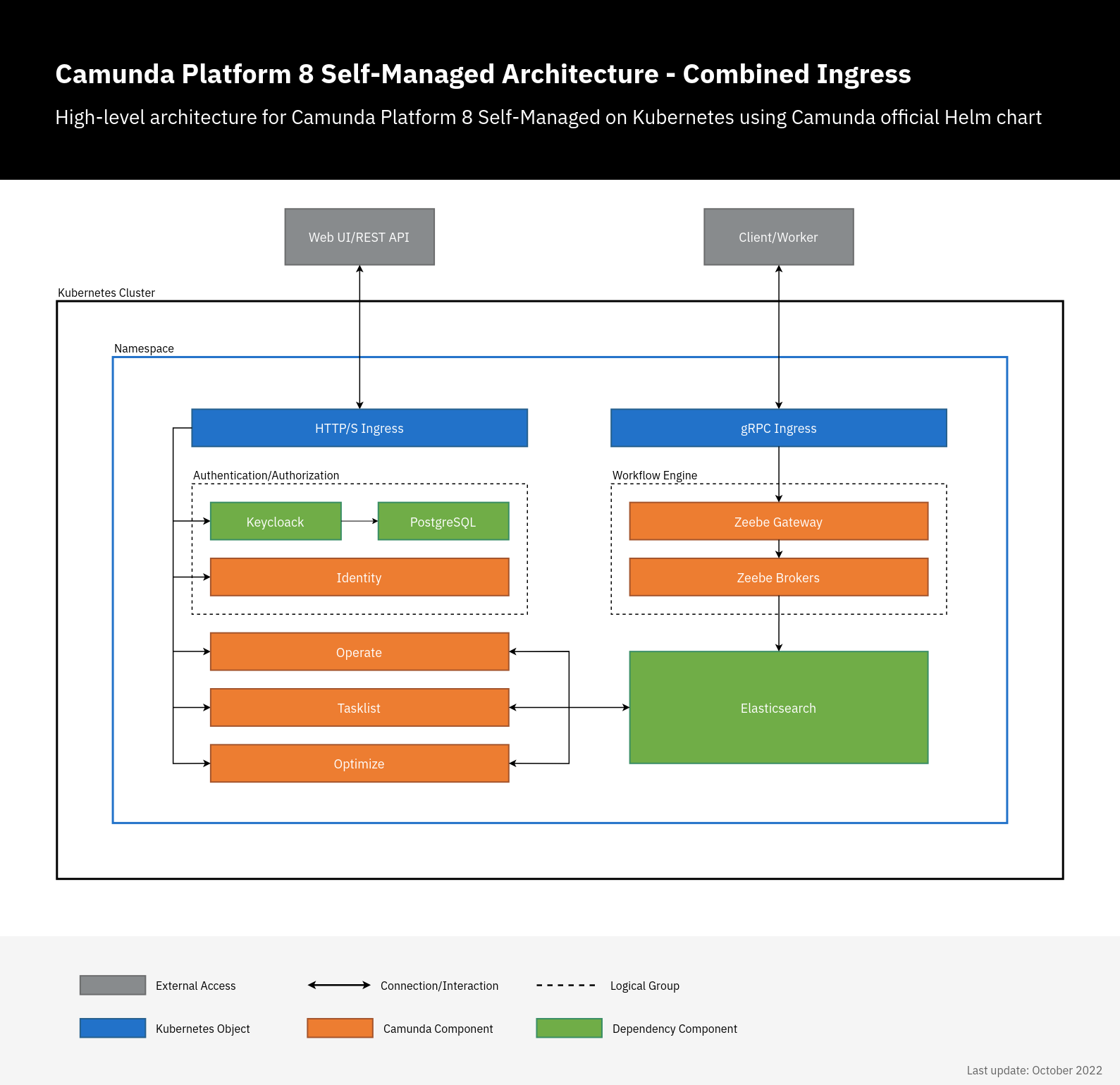- Overview
- Documentation
- Installing Charts
- Configure Charts
- Guides
- Uninstalling Charts
- Deprecation of Zeebe charts
- Issues
- Contributing
- Releasing the Charts
- License
Camunda Platform 8 Self-Managed Helm charts repo.
The Camunda Platform components are represented in the following image:
Per default the following components will be installed:
This repo is mainly for Helm charts documentation. For full details, please visit the official Camunda Platform 8 Self-Managed docs.
The charts can be accessed by adding the Camunda Helm repo:
helm repo add camunda https://helm.camunda.io
helm repo updateThen, you can install the Helm charts by running:
helm install YOUR_RELEASE_NAME camunda/camunda-platformNote For more details about deploying Camunda Platform 8 on Kubernetes, please visit the Helm/Kubernetes installation instructions docs.
We recommend using Helm on KIND for local environments, as the Helm configurations are battle-tested and much closer to production systems.
For more details, follow the Camunda Platform 8 local Kubernetes cluster guide.
Check out OpenShift Support to get started with deploying the charts on Red Hat OpenShift.
Helm charts can be configured by using extra values.yaml files or directly via the --set option.
For more details, check out the Camunda Platform 8 Helm Charts.
Default values cannot cover every use case, for that reason, we have Camunda Platform 8 deploy guides. The guides have detailed examples for different use cases like Ingress setup and so on.
You can remove these charts by running:
helm uninstall YOUR_RELEASE_NAMENote
Notice that all the Services and Pods will be deleted, but not the PersistentVolumeClaims (PVC) which are used to hold the storage for the data generated by the cluster and Elasticsearch.
To free up the storage you need to manually delete all the PVCs.
First, view the PVCs:
kubectl get pvc -l app.kubernetes.io/instance=YOUR_RELEASE_NAME
kubectl get pvc -l release=YOUR_RELEASE_NAMEThen delete the ones that you don't want to keep:
kubectl delete pvc -l app.kubernetes.io/instance=YOUR_RELEASE_NAME
kubectl delete pvc -l release=YOUR_RELEASE_NAMEOr you can simply delete the related Kubernetes namespace, which contains all PVCs.
With the creation of the Camunda Platform 8 Helm charts (previously known as ccsm-helm), the old zeebe-* charts
have been deprecated. This means they are no longer part of the repository and are no longer maintained.
However, the packaged charts are still available for download. But will be removed in the next releases.
The following charts are deprecated:
- zeebe-full-helm
- zeebe-cluster-helm
- zeebe-operate-helm
- zeebe-tasklist-helm
The new camunda-platform chart is a full replacement of zeebe-full-helm and replaces (contains) all other charts
as sub-charts. All sub-charts in camunda-platform are enabled by default.
For a complete migration guide, visit migration docs.
Please create a new issue if you find any problem in the Camunda Platform 8 Helm charts.
To start contributing to this project, please familiarize yourself with the contribution guide. Also, make sure to check the Camunda Platform Helm Charts Readme to find more information about configuring and developing the charts.
To find out how to release the charts please visit the release guide.
Camunda Platform 8 Self-Managed Helm charts are licensed under the open-source Apache License 2.0. Please see LICENSE for details.
For Camunda Platform 8 components, please visit licensing information page.


